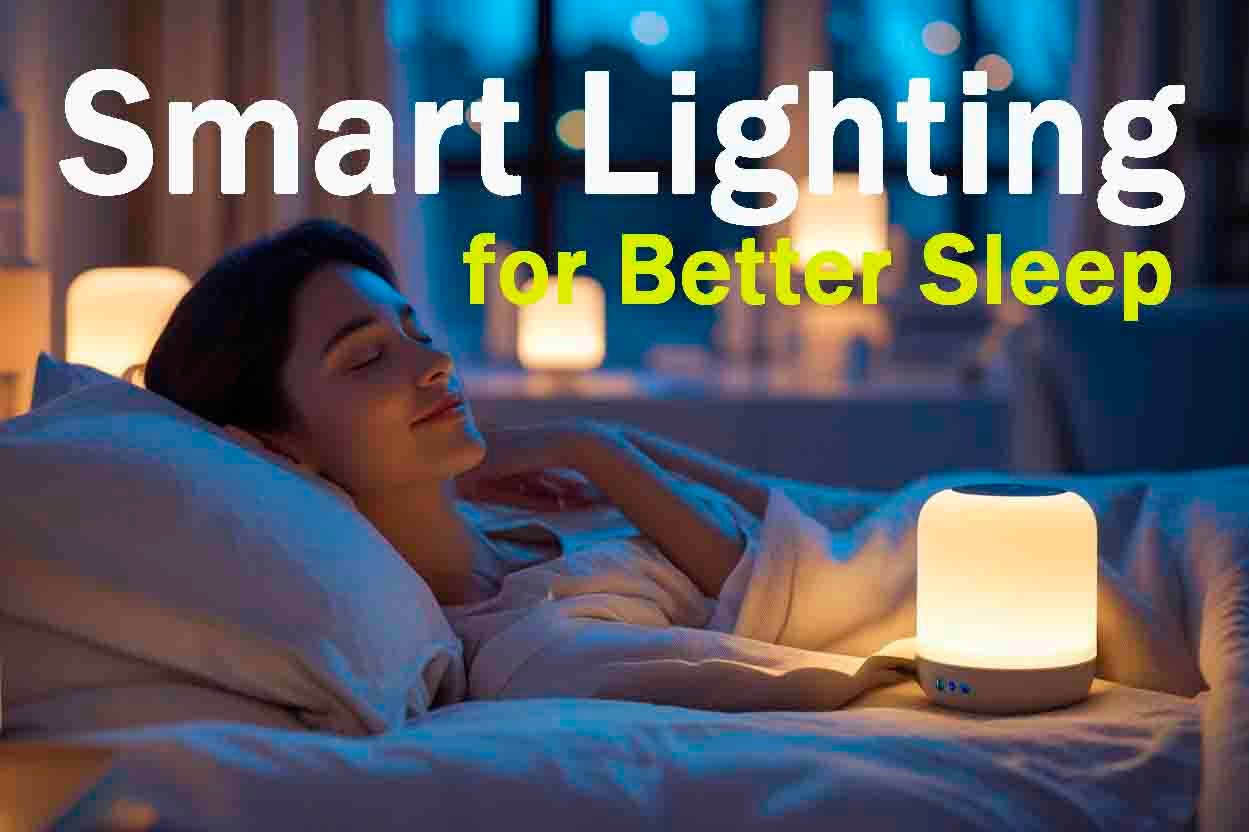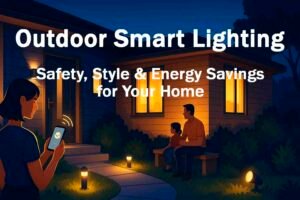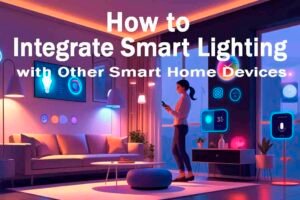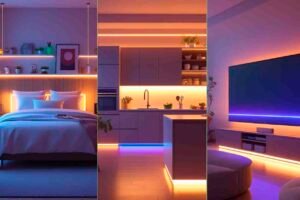Do you struggle to fall asleep or wake up feeling groggy, even after a full night’s rest? You’re not alone. Modern life—and its artificial lighting—has a huge impact on your sleep quality. Fortunately, smart lighting offers an easy, science-backed way to improve your sleep naturally, without pills or drastic lifestyle changes.
In this post, we’ll explore how light affects your sleep, and how smart lighting systems can help you fall asleep faster, sleep deeper, and wake up more refreshed.
Why Light Matters for Sleep
Our sleep-wake cycle, or circadian rhythm, is closely tied to light. Natural sunlight helps regulate the production of melatonin—a hormone that makes us sleepy. When it’s dark, melatonin levels rise. When we’re exposed to bright light (especially blue light), melatonin drops.
But here’s the problem: most artificial lighting doesn’t follow this natural pattern.
-
- Bright, cool-toned lights in the evening trick your brain into thinking it’s daytime.
-
- Inconsistent lighting in the morning disrupts your wake-up signals.
-
- Poor bedroom lighting makes it harder to wind down at night.
Smart lighting solves this.
How Smart Lighting Improves Sleep (Backed by Science)
1. Automatic Dimming in the Evening
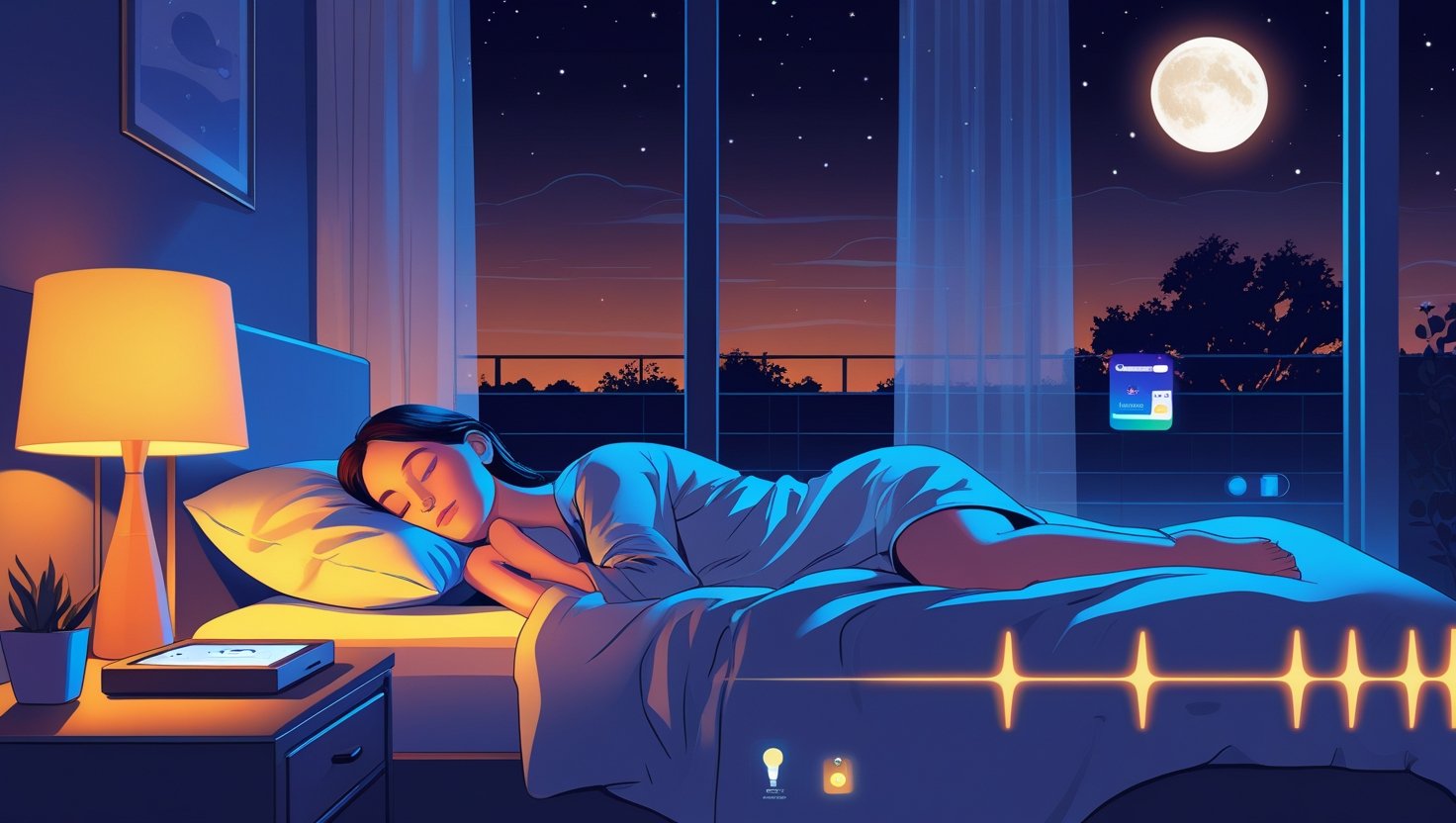
One of the most effective smart lighting features for improving sleep is automatic dimming—gradually reducing the brightness and adjusting the color temperature of your lights as bedtime approaches. This transition mimics a natural sunset, signaling your body to wind down and prepare for rest.
What Does the Science Say?
Research shows that exposure to bright, cool-toned (blue) light in the evening can delay melatonin production—the hormone that makes you feel sleepy. This tricks your brain into staying alert, even when you’re tired. On the other hand, warm, low-intensity lighting supports melatonin release, helping you fall asleep faster and experience deeper, more restorative sleep.
How Does Automatic Dimming Work?
Most smart bulbs come with a mobile app (like Hue, Govee, LIFX, or Kasa) that lets you set up a personalized dimming schedule. Here’s an example of an effective nighttime routine:
-
- 8:00 PM – Lights dim to 70% brightness and shift to a warm white (around 2700K—similar to candlelight).
-
- 9:00 PM – Brightness reduces further to 40%, with amber or orange hues.
-
- 10:00 PM – Lights turn off gradually or transition into a soft ambient night mode.
This slow fade gives your brain time to adjust, mimicking the body’s natural light-to-dark transition.
Real-Life Benefits:
-
- Reduces stress and overstimulation in the evening, creating a calm environment.
-
- Avoids disrupting your body’s internal clock, promoting more consistent sleep cycles.
-
- Saves energy, as your lights automatically use less power.
-
- Encourages a consistent bedtime routine, which improves sleep quality over time.
Pro Tip:
Use features like “Circadian Lighting” (if your app supports it) or create a preset scene such as “Relax,” “Evening,” or “Sleep Mode.” These modes will automatically adjust brightness and color to support your body’s natural wind-down process.
2. Cool, Bright Light in the Morning

Just as dim lighting in the evening helps your body wind down, exposure to cool, bright light in the morning can do the opposite—energize you, reset your internal clock, and help you wake up feeling more alert and focused. Smart lighting systems make it easy to simulate a sunrise, even on the darkest winter mornings or in rooms without much natural light.
The Science Behind It
Your body operates on a natural 24-hour rhythm called the circadian cycle, and light is the most powerful signal that tells your brain it’s time to be awake. Morning exposure to bright, blue-enriched white light suppresses melatonin (your sleep hormone) and increases cortisol, a hormone that promotes wakefulness, energy, and mental sharpness.
Studies show that morning light exposure improves mood, concentration, and sleep quality at night—especially for people who struggle with waking up early or experience seasonal affective disorder (SAD).
How to Use Smart Lighting in the Morning
Most smart lighting apps allow you to create automated wake-up routines that gradually increase brightness and shift from warm to cool tones. Here’s how to build a basic morning lighting schedule:
-
- 6:30 AM – Start with soft, warm light at around 20–30% brightness to mimic early dawn.
-
- 6:45 AM – Gradually increase brightness to 60–70% and transition to neutral white (3500K–4000K).
-
- 7:00 AM – Reach full brightness (100%) with cool white light (5000K–6500K), simulating natural daylight.
The gradual increase tricks your body into waking up naturally, rather than being shocked awake by a loud alarm or a harsh overhead light.
Where It Works Best
-
- Bedrooms – Replace your alarm clock with a sunrise simulation to wake up gently and refreshed.
-
- Bathrooms – Bright light in the morning improves grooming visibility and increases energy.
-
- Home offices/kitchens – Starting your workday or breakfast in a well-lit space helps you feel productive and alert.
Lighting Tips for Mornings
-
- Choose smart bulbs or lamps that offer a wide color temperature range (e.g., 2200K–6500K).
-
- Use motion sensors in bathrooms or kitchens to trigger cool white light automatically.
-
- Pair your lighting routine with a smart speaker alarm that plays your favorite music or nature sounds for a multi-sensory wake-up.
Benefits of Morning Bright Light:
-
- Boosts mental clarity and alertness within minutes of waking
-
- Resets your circadian clock, promoting better sleep the following night
-
- Reduces grogginess, especially for night owls or those with irregular sleep patterns
-
- Improves mood, particularly in the winter when natural sunlight is scarce
Pro Tip:
If your bedroom doesn’t get enough sunlight, use smart bulbs with “Wake-Up” or “Sunrise” presets—found in apps like Philips Hue, LIFX, and Govee. You’ll feel the difference after just a few mornings.
3. Hands-Free Control
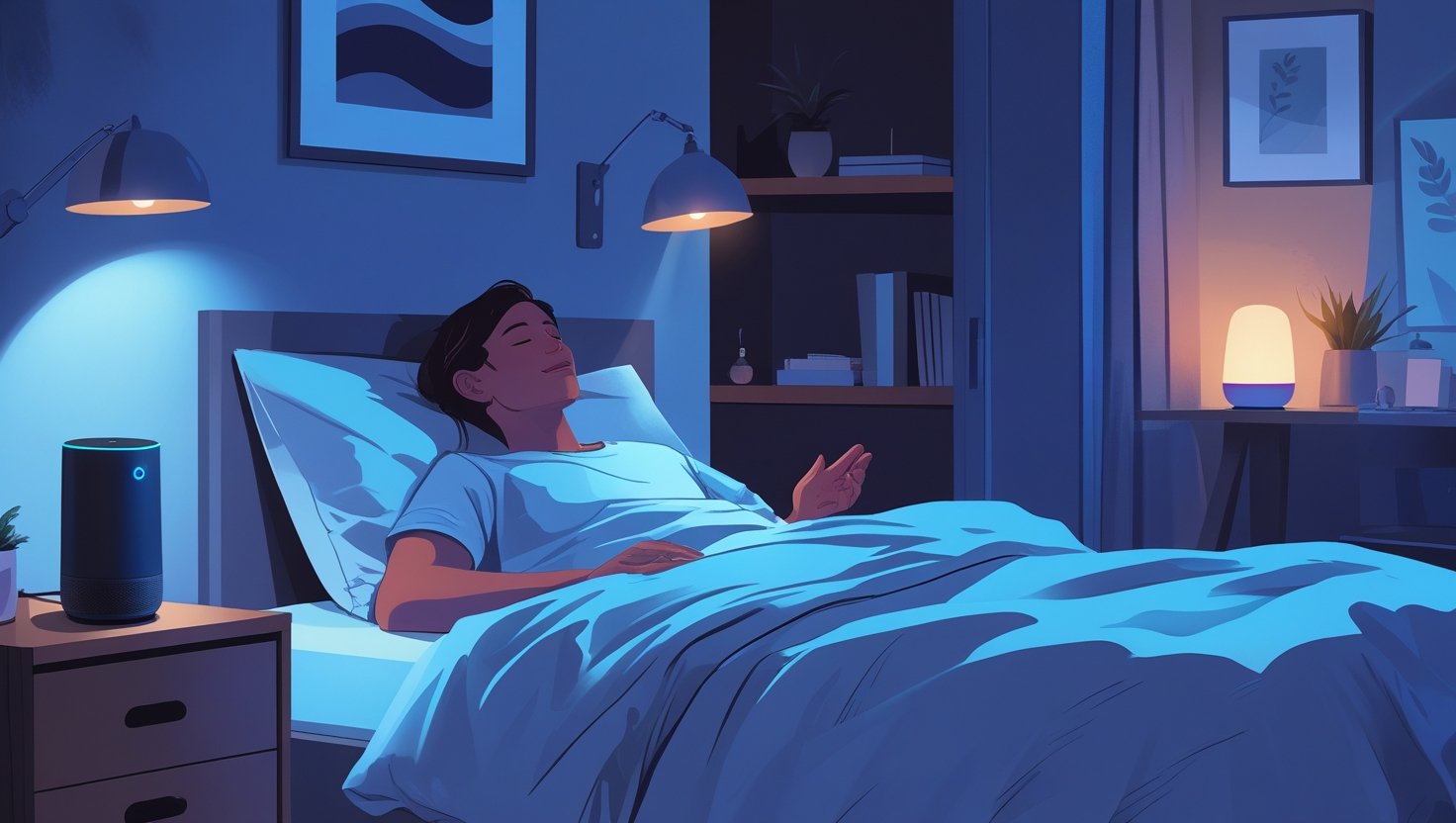
In the age of smart homes, convenience and simplicity are key—especially when it comes to your sleep environment. Hands-free control of your lighting is not just a luxury—it’s a way to improve sleep hygiene, reduce bedtime stress, and make your daily routines smoother and more consistent.
Thanks to voice assistants and automation, you can now control your bedroom lighting without ever touching a switch or your phone.
Why Hands-Free Lighting Matters for Better Sleep
At night, even small tasks—like turning off a light or adjusting brightness—can interrupt your wind-down routine. Physically getting up or reaching for a device can increase alertness and stimulate your brain, which is the opposite of what you want before bed.
Hands-free control minimizes distractions and supports a calm, uninterrupted transition to sleep by allowing you to dim the lights, switch to warmer tones, or turn everything off with a simple voice command or automatic trigger.
Voice Control: Your Personal Sleep Assistant
Most smart lighting systems work with voice assistants like:
-
- Amazon Alexa
-
- Google Assistant
-
- Apple Siri (via HomeKit)
This allows you to say things like:
-
- “Alexa, dim the bedroom lights to 10%.”
-
- “Hey Google, turn on night mode.”
-
- “Siri, turn off all lights.”
These commands are incredibly helpful when you’re already in bed or your hands are full.
Automation: Let Your Lights Follow Your Routine
Beyond voice commands, smart lighting allows you to automate your lighting schedule so you don’t have to think about it at all. For example:
-
- Lights automatically dim to 30% at 9:00 PM.
-
- Your reading lamp turns off at 10:30 PM.
-
- Motion sensors turn on a soft nightlight if you get up during the night.
You can customize these routines to your lifestyle, helping to build healthy bedtime habits and reduce reliance on disruptive devices like phones or harsh overhead lights.
Best Hands-Free Use Cases for Sleep
-
- Bedside lamps: Set a voice command like “Goodnight” to turn off all bedroom lights.
-
- Nurseries: Use motion sensors or voice control to check on a child without turning on harsh light.
-
- Hallways & Bathrooms: Automate low-level lighting for safe, non-disruptive nighttime trips.
Smart Scenes and Routines: One Command, Multiple Actions
Combine your lighting with other smart devices to create a sleep scene. For instance, a “Bedtime” scene might:
-
- Dim your lights to 20% warm white
-
- Turn off the TV and smart plugs
-
- Start white noise on a smart speaker
-
- Lock your doors and adjust the thermostat
And all of it can be triggered by a single command like:
“Alexa, goodnight.”
Benefits of Hands-Free Lighting for Sleep:
-
- Reduces bedtime screen time by avoiding smartphone use
-
- Minimizes physical movement and stimulation before bed
-
- Promotes consistent bedtime routines
-
- Improves accessibility for children, elderly, or people with limited mobility
-
- Supports a calmer, tech-enhanced sleep environment
Pro Tip:
If you share your room with someone, set up individual voice-controlled bedside lights. This allows each person to manage their own lighting without disturbing the other—perfect for couples with different sleep schedules.
4. Night Lighting Without Disruption
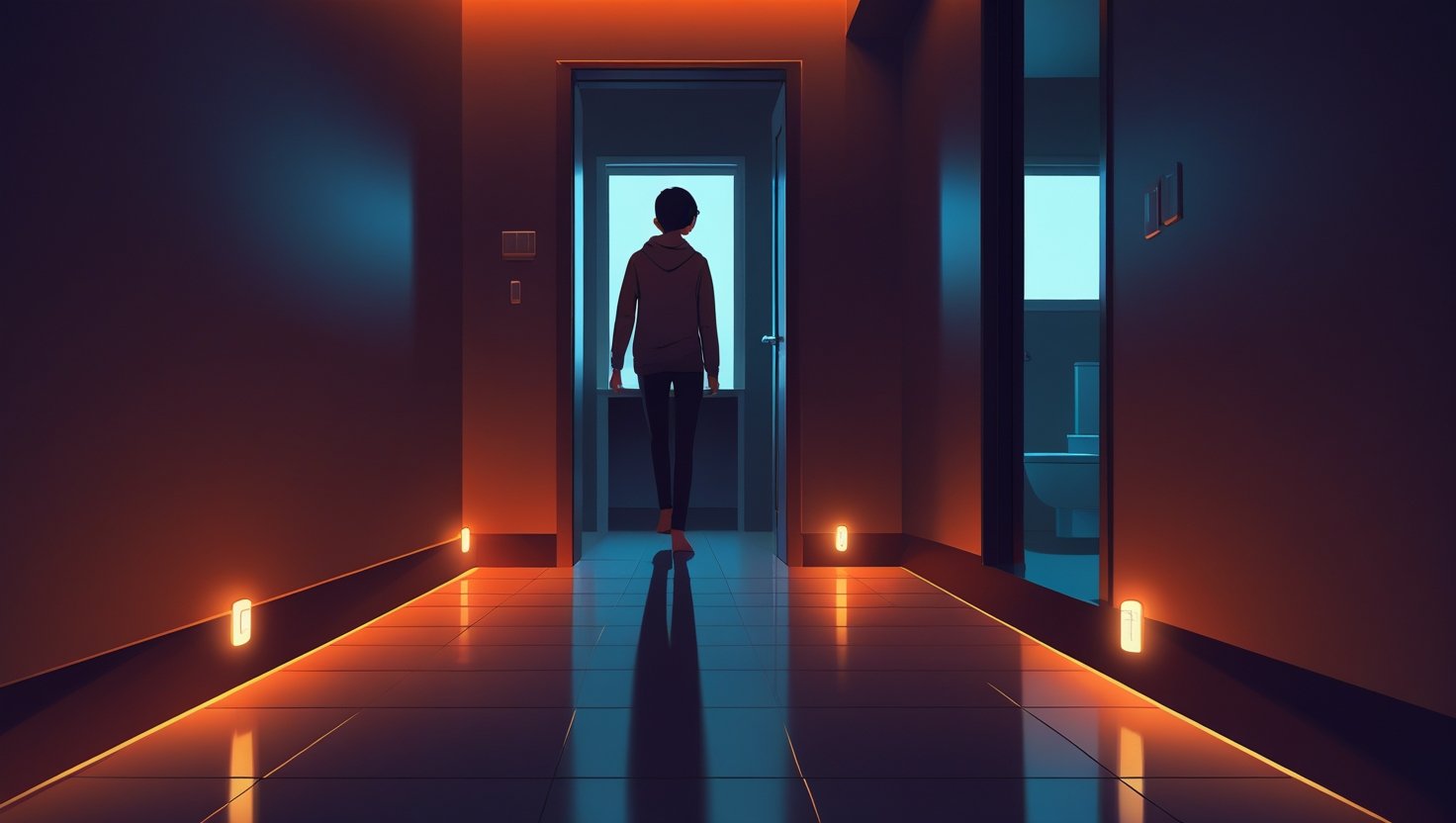
When it comes to creating a sleep-friendly environment, how you light your home at night is just as important as your morning routine. Whether you’re getting up for a glass of water, using the bathroom, or tending to a child, having light without disrupting your sleep is essential.
The good news? Smart lighting systems can provide just enough illumination to keep you safe and comfortable—without confusing your brain into thinking it’s time to wake up.
The Science of Nighttime Light
Your body’s sleep-wake cycle is deeply influenced by light exposure, especially blue and bright white light. These types of light suppress melatonin production, which can make falling back asleep much harder after nighttime wake-ups.
That’s why typical overhead lighting or phone flashlights can be so disruptive—they often emit a high level of blue light that tells your brain: “Morning’s here!”
To protect your sleep, nighttime lighting should be:
-
- Dim (under 30% brightness)
-
- Warm in tone (under 2700K, ideally 2000K–2200K)
-
- Short in duration (enough to get you where you need to go, but not more)
Smart Solutions for Gentle Nighttime Illumination
Modern smart lighting offers several features that make nighttime visibility safe and sleep-friendly:
Motion-Activated Night Lights
Place motion sensors in key areas like:
-
- Hallways
-
- Bathrooms
-
- Stairways
-
- Kids’ rooms or nurseries
When movement is detected, a soft amber or red light can automatically turn on at low brightness—and turn off again after a set period.
Why red or amber?
These tones have minimal effect on melatonin production, making them ideal for late-night use.
Scheduled Night Modes
Many smart bulbs allow you to switch to “night mode” automatically during certain hours (e.g., 10 PM to 6 AM). In this mode, bulbs limit their brightness and color temperature to avoid disrupting sleep if turned on.
Smart Plugs with Low-Light Lamps
If you prefer using lamps, plug them into smart plugs and schedule them to turn on dimly when motion is detected or a voice command is given.
Examples of Smart Night Lighting Setups
-
- Bedroom: A bedside lamp set to 10% warm light, triggered by a voice command like “Night light on.”
-
- Bathroom: A motion sensor turns on a soft 2000K LED strip under the sink or mirror.
-
- Hallway: Nightlights turn on at 15% brightness from 11 PM to 6 AM.
-
- Nursery: A touch-sensitive smart lamp with a red glow allows you to check on a child without waking them.
Why This Matters
By reducing harsh light during nighttime awakenings, you’re protecting your melatonin cycle and making it easier to fall back asleep quickly. This contributes to deeper, more restorative rest over the long term.
Smart lighting also adds a layer of safety and comfort—especially for:
-
- Children
-
- Elderly individuals
-
- Anyone prone to nighttime trips or waking easily
Benefits of Non-Disruptive Night Lighting:
-
- Helps you return to sleep faster after waking
-
- Supports natural melatonin production
-
- Prevents accidents or disorientation in the dark
-
- Reduces the need to grab your phone or turn on bright lights
-
- Creates a safer and more relaxing nighttime environment
Pro Tip:
Use smart bulbs that support ultra-warm color temperatures (like 1800K–2000K) or dedicated sleep-friendly nightlight modes. Brands like Philips Hue, Govee, and Wyze offer great options.
5. Smart Scheduling and Routines
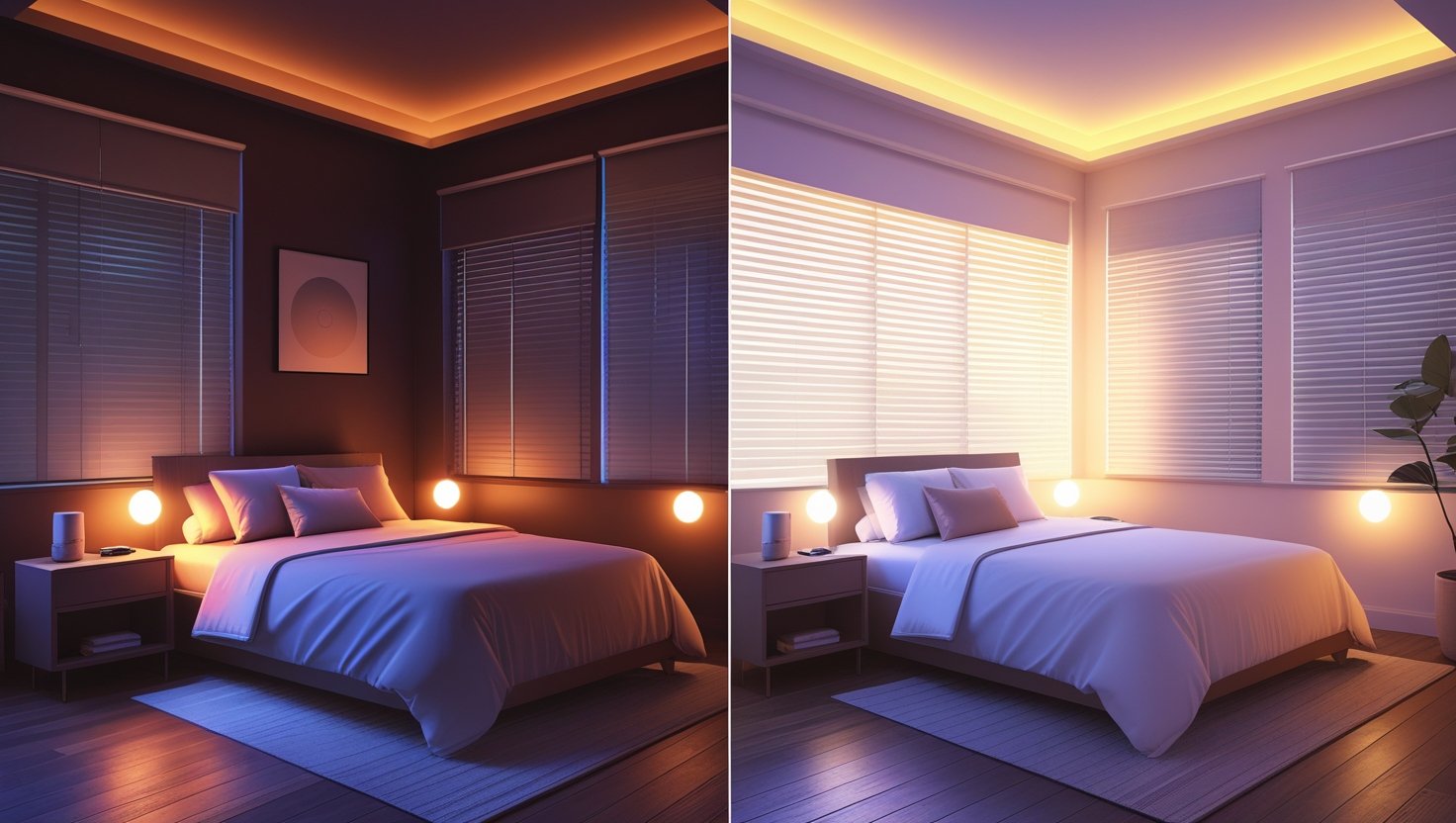
One of the most powerful benefits of smart lighting is the ability to automate your lighting environment through schedules and routines. Rather than manually adjusting lights throughout the day, you can let your lighting system work for you—in harmony with your body’s natural circadian rhythms.
This isn’t just about convenience. Well-planned light routines can support your sleep-wake cycle, improve your energy levels, and reduce evening overstimulation.
Why Lighting Schedules Matter
Your brain uses light cues to regulate melatonin—the hormone responsible for making you sleepy. Bright, cool light in the morning helps stop melatonin production, while dim, warm light in the evening helps start it back up.
By automating these light transitions, you train your body to wind down and wake up more naturally. This can improve both sleep quality and consistency, which are key for long-term health and mood stability.
How Smart Scheduling Works
Most smart lighting systems (like Philips Hue, Govee, LIFX, or TP-Link Kasa) let you create lighting schedules through their companion apps or through voice assistants like Alexa, Google Assistant, or Siri.
You can program schedules to:
-
- Turn lights on or off at specific times
-
- Gradually dim or brighten lights over a set period
-
- Shift the color temperature from cool to warm tones
-
- Sync with sunrise and sunset
-
- Change based on day of the week or presence detection
Example: Morning Wake-Up Routine
Wake up naturally with a simulated sunrise that gradually increases brightness and color temperature over 30 minutes.
Example Schedule:
-
- 6:30 AM – Light turns on at 1% brightness (warm tone)
-
- 6:40 AM – Brightness increases to 30% (cooler tone)
-
- 6:50 AM – Bright white light (100%) fills the room, telling your body it’s time to get up
This method can be especially helpful in winter months when natural daylight is limited.
Example: Evening Wind-Down Routine
Ease into sleep with a gradual dimming schedule that helps lower cortisol and raise melatonin.
Example Schedule:
-
- 8:30 PM – Lights shift to amber or warm white (2200K)
-
- 9:00 PM – Brightness decreases to 50%
-
- 9:30 PM – Lights dim to 10% or turn off automatically
Combine this with a “Good Night” voice command that shuts off all non-essential lighting or activates night lights.
Smart Routines You Can Try
-
- “Wind Down” Scene: Starts your bedtime lighting and turns off screens or bright overhead lights
-
- “Wake-Up Weekdays” Routine: Simulates sunrise only Monday–Friday
-
- “Weekend Mode”: Delays wake-up lighting for slower, more restful mornings
-
- “Nightlight Auto-On”: Automatically turns on low lighting if motion is detected between 11 PM and 6 AM
-
- “Lights Out” Command: One voice command to turn off all lights in your home when you’re ready to sleep
Tips for Better Results
-
- Keep it consistent. Try to follow the same wake/sleep lighting pattern every day.
-
- Use gradual transitions. Sudden light changes can jolt your system; aim for smooth fades over 15–30 minutes.
-
- Pair with sound or aroma. Use routines that include relaxing sounds or diffusers (via smart plugs) for multi-sensory wind-down effects.
-
- Avoid bright white light after 8 PM. Stick to warm, amber tones for all evening lights.
Which Platforms Support Smart Routines?
-
- Philips Hue: Excellent for complex automation with sunrise/sunset, geolocation, and “Hue Labs” formulas
-
- Alexa & Google Home: Simple voice-triggered or schedule-based routines
-
- Apple HomeKit: Great for secure automation based on presence, time, or accessories
-
- Govee, LIFX, Kasa: App-based scheduling with color and dimming controls
Benefits of Smart Lighting Routines:
-
- Promotes healthier circadian rhythms
-
- Helps you fall asleep faster and wake up more refreshed
-
- Reduces manual effort and screen exposure before bed
-
- Creates a more predictable and peaceful home atmosphere
-
- Works perfectly for children’s bedtime or household-wide routines
Best Smart Lights for Better Sleep
Here are a few systems perfect for sleep-enhancing routines:
-
- Philips Hue – Great for color transitions, sunrise/sunset simulation, and deep customization.
-
- Govee – Affordable RGB lights with excellent scheduling features.
-
- LIFX – High-quality bulbs with rich colors and no need for a hub.
-
- Nanoleaf – Ideal if you want mood lighting that’s also artistic.
Looking to upgrade your lighting setup? Check out our Top 5 Smart Lighting Systems to find the perfect devices for creating a sleep-friendly environment.
Final Thoughts
Poor sleep doesn’t have to be your norm. By syncing your lighting with your body’s natural rhythms, smart lights offer a powerful, low-effort way to improve your rest.
Whether you’re a tech lover or just tired of being tired, upgrading to a smart lighting system might be the best decision for your health and well-being.


